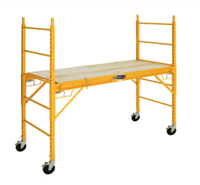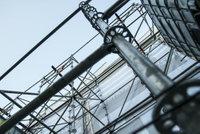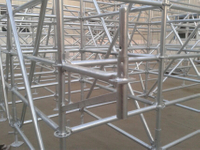Content Menu
● Introduction to Frame Scaffolding
● Components of Frame Scaffolding
● Step-by-Step Guide to Building a Frame Scaffolding
>> Step 1: Plan Your Scaffolding Layout
>> Step 2: Gather Necessary Materials and Tools
>> Step 3: Assemble the Vertical Posts (Standards)
>> Step 4: Install Horizontal Braces (Ledgers and Transoms)
>> Step 5: Add Diagonal Braces for Stability
>> Step 6: Install Platform Decks
>> Step 7: Add Guardrails
● Safety Considerations
● Common Safety Mistakes
● Maintenance and Inspection
● Inspection Checklist
● Training and Certification
● Training Topics
● Conclusion
● FAQ
>> 1. What are the essential components of frame scaffolding?
>> 2. How do you ensure stability in frame scaffolding?
>> 3. What safety features should frame scaffolding include?
>> 4. Why is planning crucial before building frame scaffolding?
>> 5. What tools are necessary for assembling frame scaffolding?
● Citations:
Building a frame scaffolding is a crucial task in the construction industry, providing a safe and stable platform for workers to perform tasks at heights. This article will guide you through the step-by-step process of constructing a frame scaffolding system, highlighting the essential components and safety considerations.
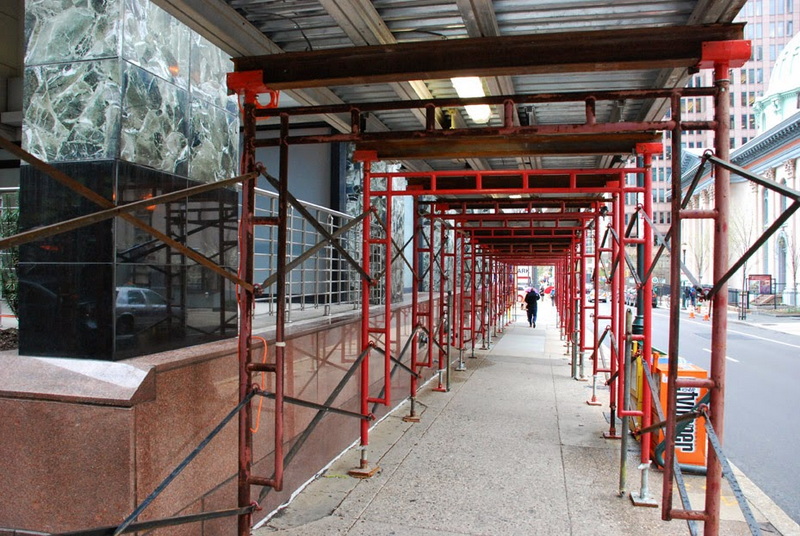
Introduction to Frame Scaffolding
Frame scaffolding is a versatile and widely used type of scaffolding due to its modular design and ease of assembly. It consists of steel frames, cross braces, platform planks, and screw jacks, which work together to create a robust structure. Understanding the components and their roles is essential for building a safe and efficient scaffolding system.
Components of Frame Scaffolding
- Steel Frames: These are the main structural elements, providing the vertical support.
- Cross Braces: These add stability by connecting the frames horizontally.
- Platform Planks: These are the surfaces on which workers stand.
- Screw Jacks: Used to adjust the height and level of the scaffold.
Step-by-Step Guide to Building a Frame Scaffolding
Step 1: Plan Your Scaffolding Layout
Before starting construction, assess the area where the scaffolding will be erected. Consider the dimensions of the structure you need to access, the weight load requirements, and any potential obstacles. Create a detailed layout plan indicating the positions of each standard, ledger, and brace. Ensure that your plan complies with local safety regulations and industry standards.
Step 2: Gather Necessary Materials and Tools
Assemble all the required materials and tools for your frame scaffolding system. This includes steel pipes or tubes for standards and ledgers, adjustable couplers, diagonal braces, platform decks, safety nets, and any hardware necessary for assembly. Ensure that all materials meet the required safety standards. Tools such as wrenches, hammers, tape measures, and level tools will also be essential.
Step 3: Assemble the Vertical Posts (Standards)
Place the vertical posts at the marked positions, ensuring they are plumb and evenly spaced. Use adjustable couplers to connect the posts at the desired heights. It's crucial to maintain vertical alignment to prevent swaying and instability. If working with multiple tiers, ensure each tier is level before proceeding to the next.
Step 4: Install Horizontal Braces (Ledgers and Transoms)
After setting up the vertical posts, install the horizontal braces. Ledgers run parallel to the building wall, providing horizontal support. Transoms connect adjacent standards across the width of the scaffolding. Use adjustable couplers to secure these braces firmly in place. Ensure that all connections are tight to prevent movement.
Step 5: Add Diagonal Braces for Stability
Diagonal braces are crucial for providing lateral stability to the frame scaffolding system. Install them in an 'X' pattern between adjacent standards and ledgers. This creates a triangular support system, which is inherently stable. Check that each brace is securely fastened and that the entire structure feels rigid.
Step 6: Install Platform Decks
Once the frame is stable, install the platform decks. These decks should be securely attached to the ledgers to prevent movement. Ensure that the decks are level and provide a safe working surface. It's also important to check the load capacity of the decks to ensure they can handle the weight of workers and equipment.
Step 7: Add Guardrails
Install guardrails around the platform to prevent falls. Guardrails should be at least 1 meter high and include midrails for added safety. Ensure that the guardrails are securely attached to the scaffolding structure.
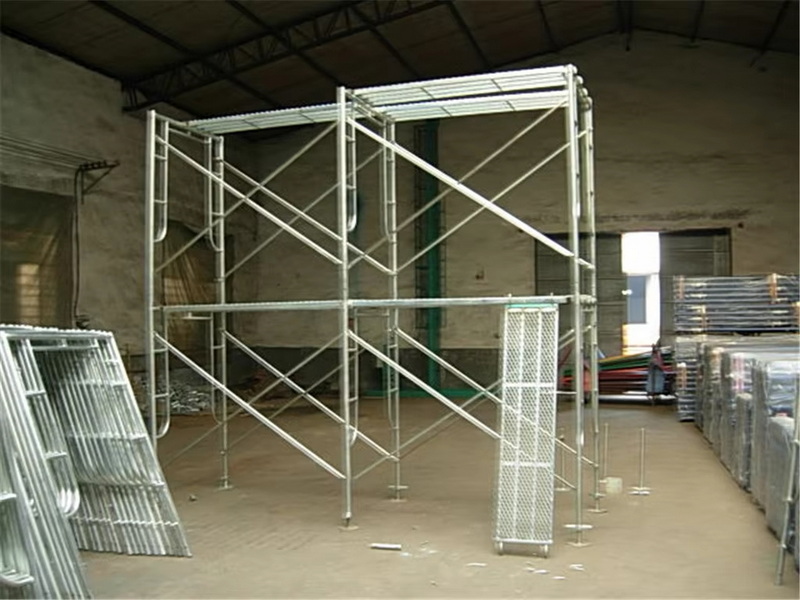
Safety Considerations
Safety is paramount when building and using frame scaffolding. Always follow local safety regulations and industry standards. Ensure that all components are securely fastened, and the structure is level and plumb. Regular inspections should be conducted to identify any potential hazards.
Common Safety Mistakes
- Inadequate Bracing: Failure to install sufficient diagonal bracing can lead to instability.
- Incorrect Assembly: Improperly assembled scaffolding can collapse or sway, posing a significant risk to workers.
- Insufficient Guardrails: Guardrails must be installed correctly to prevent falls.
Maintenance and Inspection
Regular maintenance and inspection are crucial for ensuring the longevity and safety of the scaffolding. Check for any signs of wear or damage, such as rusted components or loose connections. Perform routine cleaning to prevent debris accumulation, which could compromise stability.
Inspection Checklist
- Structural Integrity: Ensure all components are securely attached and show no signs of damage.
- Load Capacity: Verify that the scaffolding can handle the intended load.
- Guardrails: Check that guardrails are properly installed and secure.
Training and Certification
It's essential that anyone involved in building or using frame scaffolding receives proper training and certification. This includes understanding safety protocols, assembly procedures, and how to conduct regular inspections. Training programs should cover both theoretical knowledge and practical skills.
Training Topics
- Scaffolding Assembly: Hands-on training in assembling scaffolding components.
- Safety Procedures: Understanding safety regulations and emergency response protocols.
- Inspection Techniques: Learning how to identify potential hazards and perform routine inspections.
Conclusion
Building a frame scaffolding requires careful planning, precise execution, and adherence to safety standards. By following the steps outlined in this guide, you can construct a stable and efficient scaffolding system that meets your project needs. Remember, safety should always be the top priority when working at heights.
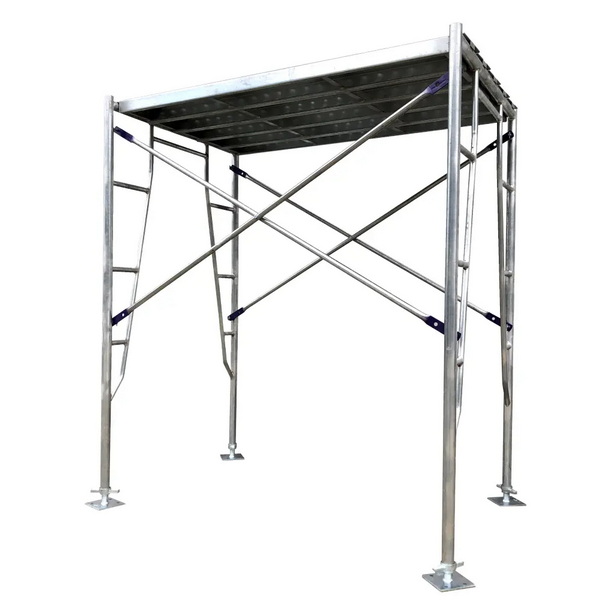
FAQ
1. What are the essential components of frame scaffolding?
The essential components include steel frames, cross braces, platform planks, and screw jacks.
2. How do you ensure stability in frame scaffolding?
Stability is ensured by installing diagonal braces in an 'X' pattern between adjacent standards and ledgers.
3. What safety features should frame scaffolding include?
Safety features should include guardrails, midrails, and secure platform decks to prevent falls and ensure a stable working surface.
4. Why is planning crucial before building frame scaffolding?
Planning is crucial to ensure that the scaffolding meets the project's specific needs, complies with safety regulations, and accounts for potential obstacles.
5. What tools are necessary for assembling frame scaffolding?
Necessary tools include wrenches, hammers, tape measures, level tools, and any hardware required for assembly.
Citations:
[1] https://scaffoldingrentalandsales.com/blog/how-to-build-a-scaffolding-tower/
[2] https://www.datocms-assets.com/48781/1626165723-mounting-instruction-scaffolds-st-rt-fteng.pdf
[3] https://www.yueyangcz.com/new_detail/How-to-build-a-frame-scaffolding.html
[4] https://pdf.lowes.com/productdocuments/23822ca6-ca50-4263-9581-8808d97e05e1/01055198.pdf
[5] https://dss.net/frame-scaffolding-system/
[6] https://brandsafway.com/uploads/files/orn703_bsl_safmax_assembly_instructions.pdf
[7] https://www.finehomebuilding.com/2004/01/01/simple-homemade-scaffolding
[8] https://www.alfix-systems.com/wp/wp-content/uploads/2019/08/EN-INSTRUCTIONS-ALBLITZ-70-A.pdf
[9] https://www.allcotthire.com.au/wp-content/uploads/2020/02/Scaffold-Erection-Guide-A4_Allcott-Hire.pdf













